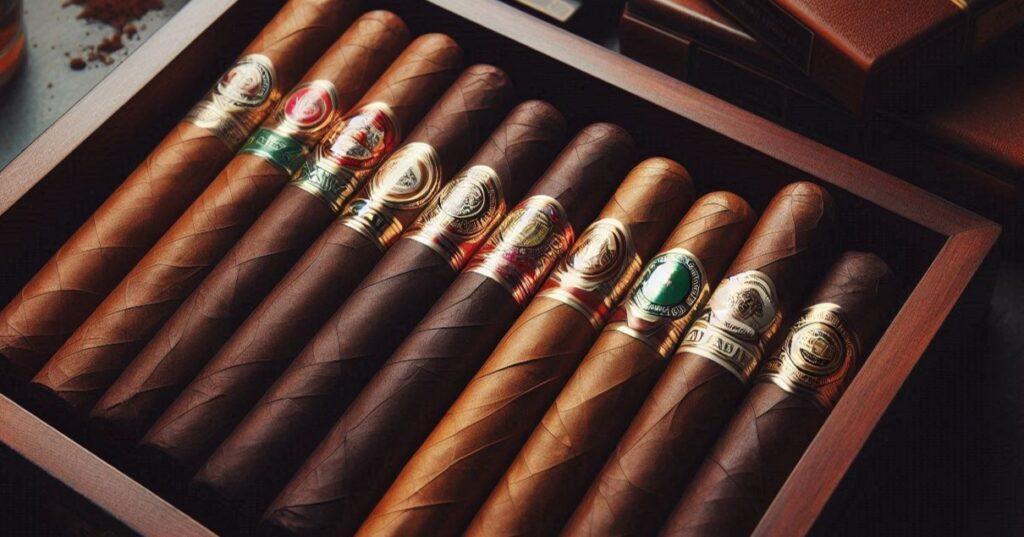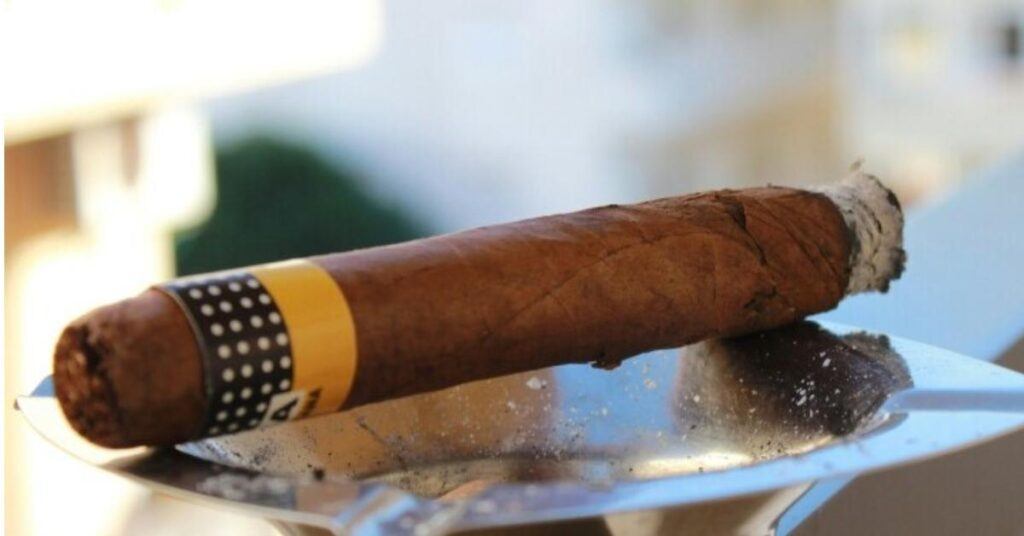
Getting into the cigar hobby is intimidating. You will get it in no time and then it becomes a rewarding hobby that keeps on giving.
Cigar BluePrint
At the heart of every cigar, you’ve got three main parts:
- the wrapper
- the binder
- the filler
Wrapper
Think of the wrapper as the outer beauty—the part you admire right away. It’s usually the most expensive part of a cigar. A smooth, even-colored wrapper indicates quality. Moving inside,
Binder
the binder holds the filler together. It’s like the glue of the operation, keeping everything from falling out.
Filler
The filler is where a lot of the magic happens, where you get the good stuff like taste and strength from.
Size
Heres some more jargon to throw your way when it comes to cigars. Size matters when it comes to cigars. Trust me!
- gauge
- length
- shape
Gauge
This is the diameter and is measured in 64ths of an inch. Yep, you heard that right!
Length
Length is simpler—just how long the cigar is from end to end.
Both these elements can subtly change your smoking experience.
Shape
The shape—here is where things get interesting—comes in straight-sided (parejos) and all sorts of tapering and unique shapes (figurados).
parejos
- Corona
A balanced, traditional shape with a ring gauge between 42-46 and a length of about 5.5-6 inches. It has a consistent flavor profile due to its classic size. - Petit Corona
Smaller than the classic Corona, usually around 4.5 inches long with a ring gauge of 40-42. Ideal for a quick smoke while delivering concentrated flavors. - Robusto
One of the most popular sizes, known for its 5-inch length and 50 ring gauge. Offers a rich and complex smoking experience in a relatively short time. - Churchill
Known for its longer length of around 7 inches and a 47-50 ring gauge, delivering a longer, more leisurely smoke with a gradual evolution of flavors. - Lonsdale
A slimmer, elegant cigar at about 6.5 inches with a 42 ring gauge. It provides a balanced, medium-length smoke with a slow burn. - Double Corona
Larger than the standard Corona, usually 7.5-8 inches long with a ring gauge of around 49-52. Ideal for long smoking sessions. - Toro
Similar to the Robusto but larger, generally around 6 inches long with a 50-54 ring gauge. Provides more smoking time and robust flavor development.
figurados
- Torpedo Features a pointed head that allows for a controlled draw and a concentrated flavor. Often around 6 inches long with a 50 ring gauge.
- Belicoso A shorter, stockier version of the Torpedo, typically about 5-5.5 inches with a 50-52 ring gauge. Known for delivering a rich, intense flavor.
- Pyramid Similar to the Torpedo, but it tapers more gradually from a wide foot to a narrow head. Allows for an even burn and gradual flavor evolution.
- Perfecto Both ends are typically rounded or closed, with a bulbous center. This shape allows for a unique start with flavor variations as it burns.
- Culebra This rare shape consists of three slender cigars braided together, typically about 5-6 inches long. Traditionally smoked one stick at a time.
- Diadema A long, tapered cigar that can reach up to 9 inches, with one or both ends closed. Its unique size provides a long, complex smoking experience.
Dont Get Overwhelmed
I know when you are just getting started this can be confusing. Might sound strange, but size matters when it comes to things like aroma, flavor, mouth feel. A longer, thicker cigar burns cooler and typically offers a nuanced flavor trip. Meanwhile, a shorter or thinner cigar might pack a bit of a punch with a quicker burst of flavors. Starting with a few different sizes will tell you what size you really prefer.
Exploring Cigar Color: Beyond Just Light to Dark
Cigar colors might seem like just a shade difference, but it’s going to change everything about the cigar based on what color the wrapper is. Let’s talk wrapper colors. These range from light to dark, and each has its distinct vibe and flavor contribution.
Claro
Claro cigars, with their light, golden-brown appearance, usually offer a milder and more mellow profile. Perfect if you’re stepping into cigars for the first time or looking for something easy-going.
Colorado
Getting a bit richer in hue, the Colorado wrappers flaunt a medium-brown tone that balances sweetness with a pinch of spice. It’s like that comfy middle seat—reliable and pleasantly steady.
Maduro
Then comes the Maduro, with deeper browns that promise a sweet, rich, and robust journey. These are perfect for when you’re up for more pronounced flavors. Expect some chocolate or coffee notes in there, making for a luscious experience.
Oscuro
The Oscuro, almost black, is both bold in color and flavor. It’s the heavyweight, bringing deep earthy tones and often a surprisingly smooth finish, typically loved by seasoned smokers.
It’s crucial to note that the color often reflects the curing and fermentation processes the tobacco has undergone. The way the leaves are handled changes their flavor, making wrapper selection an adventure in itself.
Next time you’re picking a cigar, consider its color like a preview of the flavor story it holds. Different hues mean different experiences, so explore around until you find the ones that sync with your taste.

A Global Tour of Cigar Regions: Where Quality Meets Tradition
Cigars aren’t just about taste; they’re about the journey from seed to smoke, and that journey roots itself deeply in specific regions around the world. Each cigar-producing country has its own flair and style, making your cigar experience as unique as the place it comes from.
Cuba
The best place to grow premium cigars, offers cigars known for their rich flavors and complex profiles. The combination of fertile soil and traditional techniques help create legendary smokes that are beloved by aficionados everywhere. Good luck getting them though.
Dominican Republic
producing some of the world’s finest tobaccos. Here, cigars often lean toward a milder, creamier experience with a smooth finish that’s perfect for both beginners and seasoned smokers.
Nicaragua
has emerged as a powerhouse in the cigar world, crafting cigars that pack a serious flavor punch with their spicy, bold notes. The varied landscapes and volcanic soils play a big role in developing the unique taste profiles associated with Nicaraguan cigars.
Regional Influences
Each region’s unique soil, climate, and craftsmanship significantly influence a cigar’s flavor and aroma. For example, the earthy richness you might find in a Honduran cigar could surprise you, offering a beautiful balance of spiciness and robustness.
While these are some of the most renowned regions, don’t overlook places like Honduras or Mexico, which also contribute uniquely flavorful tobacco leaves to the global scene.
Region Matters
When choosing a cigar, consider where it was grown. The region is going to give you a hit of the flavor profiles through the computer. Exploring cigars from different regions not only broadens your palate but also deepens your appreciation for the diverse craftsmanship that the cigar world offers.
Finding Your Perfect Cigar: Tips for Selecting the Right Type
Choosing the right cigar can feel like a daunting task, especially with such a vast range of options out there. But don’t worry—finding your perfect match can be an enjoyable adventure. Start by considering the occasion. Are you celebrating a big event, or do you just want something to relax with after a long day? Different occasions might call for different experiences.
Palate
Your personal palate is the biggest item of importance when picking out a cigar. If you’re a fan of bolder flavors, something from Nicaragua with its spicy notes might suit you. But if you prefer a milder experience, a Dominican cigar might be more up your alley. With time you’ll get the hang of what you prefer. If you’re just starting out, you might want to start with something on the mild side and gradually explore stronger, more complex flavors as your palate develops.
Labels
Reading the labels are going to tell you a rough story about each cigar. Look for indicators of quality and the type of tobacco used. Knowledge of brands and their reputations can guide you, offering insight into what kind of smoking experience you might receive.
Go To Your Shop
When it comes to purchasing, you can’t beat the in-person experience of visiting a cigar shop. Engaging with a knowledgeable store owner can provide valuable advice and they will help you find the flavors you like.
Online Shops
online shops are here for when your shop doesn’t carry the hit your looking for, often with detailed reviews and notes to guide your choice.
Whatever path you choose, it’s about balancing your preferences with curiosity. Don’t hesitate to try something new or unknown. The world of cigars is vast, and with each new cigar comes the potential for an extraordinary experience.
Savoring the Experience: How to Properly Enjoy a Cigar
There’s more to enjoying a cigar than just lighting up. It’s a ritual that begins with a careful cut. Using a guillotine cutter or a punch, aim for a clean cut to ensure smooth airflow. A poorly cut cigar can mess with both the draw and even the flavors you get from it.
Lighting
Lighting up a cigar isn’t as simple as using a lighter. You will want to use either matches or a butane lighter, ensuring no unwanted tastes mess with the cigar. Toast the foot of the cigar first, using a circular motion to get a uniform burn before bringing it to your lips and puffing lightly.
Smoking
While smoking, take it slow, this isn’t a race. The pleasure lies in savoring each flavor note. Puffing too quickly heats things up, which can burn away the nuances and leave a bitter taste. Pause between puffs to appreciate the aroma and flavors unfolding with each draw.
Pairings
Pairing your cigar with a drink is always a must for me. It just seems to elevate my experience to the next level. A robust red wine or rich whiskey often complements the complexity of a good cigar. Even a strong coffee can work wonders, adding its own layer of depth to your indulgence.
Leave it Be
Once done, We’re not putting out a cigarrette here we are mourning the loss of a collectors piece. Set it down in an ashtray and let it extinguish itself gracefully. This process is part of preserving the serene vibe cigars already provide. Also you wont smoke everyone out with burnt cigar smells. Vibe KILLER
Cigar Care
Care for your cigars so they will care for you later. Proper storage in a humidor maintains optimal humidity levels. Without it, cigars dry out, which hurts flavors much like leaving good wine open for too long.
Appreciation
Appreciating a cigar is part art, part science. With a bit of patience and attention to detail, the experience becomes much more than a simple pastime. It’s a moment of enjoyment and relaxation, meant to be truly savored.


This is a fantastic guide to understanding cigars! I love how you’ve broken down the different components of a cigar, from the wrapper to the filler, and explained how each part contributes to the overall experience. It’s also great that you touched on the importance of size, shape, and color in shaping the flavors.
Also, I appreciated the section on cigar care, keeping cigars in a humidor makes such a difference in preserving their flavors, something I learned the hard way after a few dry cigars. Overall, this is a well-rounded and accessible guide for both beginners and seasoned cigar aficionados!
Thank you so much! I honestly learned the hard way with my first humidor of cigars being lost to drying out as well. (won’t make that mistake again.)
I believe it takes time for you to find your perfect cigar configuration you just keep going back to. I find that mine is a Churchill cigar from Nicaragua such as my all time favorite go-to which is the Padron Original Maduro.